To make gluten-free pasta from scratch, start by choosing your flours, like almond or chickpea, and mix in xanthan gum for elasticity. Combine the flours and any binding agents, like eggs or flaxseed meal, kneading until it reaches the right texture. Roll out the dough to your desired thickness, then cut it into shapes you love. Cook your pasta in salted water until al dente, and toss it with flour to prevent sticking. For added flair, incorporate herbs or serve it with your favorite sauce. Keep exploring these ideas for an even tastier pasta experience!
Key Takeaways
- Select a blend of gluten-free flours like almond, brown rice, and chickpea flour for optimal texture and nutrition.
- Incorporate binding agents such as eggs or aquafaba to help the dough hold together.
- Roll out the dough evenly after resting, ensuring consistent thickness for even cooking.
- Cut the pasta into desired shapes and toss with flour to prevent sticking before cooking.
- Boil in salted water until al dente, then pair with your favorite sauces and toppings for serving.
Essential Ingredients Needed
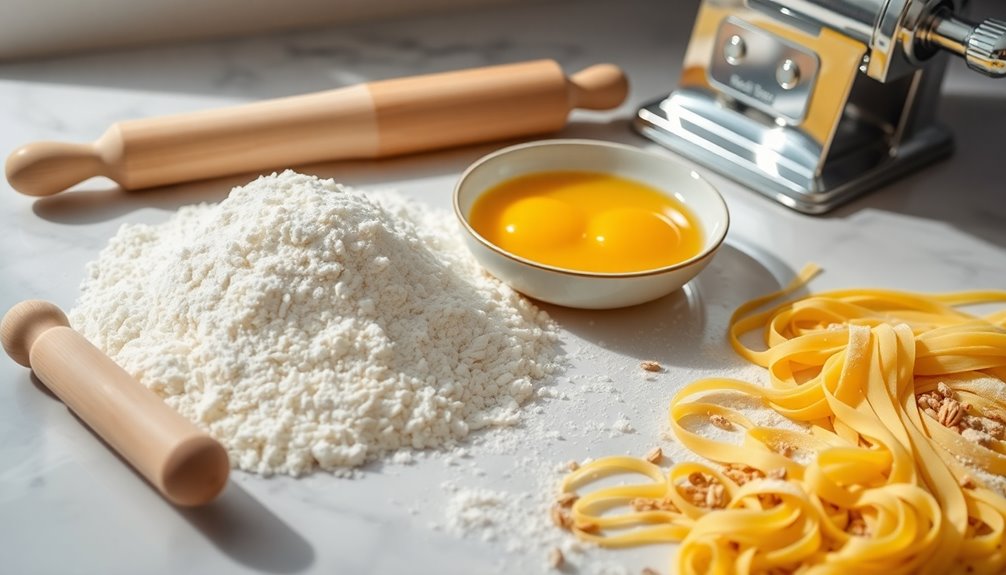
When you're ready to whip up some delicious gluten-free pasta, having the right ingredients on hand is crucial. The foundation of your pasta lies in the flour alternatives you choose. Popular options include almond flour, brown rice flour, and chickpea flour. Each brings its unique texture and flavor, so don't hesitate to experiment until you find the combination that feels right for you.
Next, you'll want to think about binding agents. Since gluten is what usually holds traditional pasta together, you'll need substitutes like xanthan gum or psyllium husk. These ingredients help create that desirable elasticity, making your pasta enjoyable and satisfying.
Don't forget about eggs! They add richness and help with the overall structure of your pasta. If you're vegan or avoiding eggs, think about using aquafaba or flaxseed meal mixed with water as an alternative.
When shopping, you might come across various gluten-free pasta brands that offer pre-made options. While making pasta from scratch is rewarding, having these brands as a backup can save you time and make sure you have something delicious on hand when life gets busy. Additionally, it's essential to choose low glycemic ingredients to help maintain stable blood sugar levels, as high glycemic foods can trigger cravings and weight gain.
Choosing the Right Flour
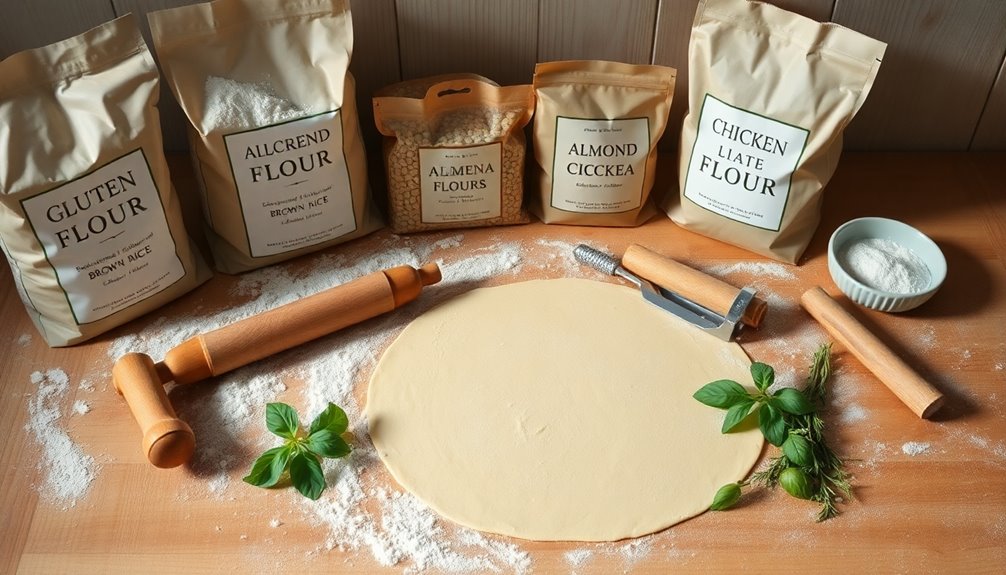
Selecting the right flour is key to crafting the perfect gluten-free pasta, and with a variety of options available, you can find the ideal match for your taste and texture preferences. Different flours come with unique properties that can significantly influence the final dish's flavor and mouthfeel.
One popular choice is almond flour, which adds a slightly sweet, nutty flavor and a tender texture. It works wonderfully for those who enjoy a softer pasta.
If you prefer something a bit heartier, consider brown rice flour. It offers a mild taste with a slightly chewy texture, making it a fantastic foundation for your pasta.
For those seeking a more traditional pasta feel, a blend of flours, like tapioca or potato starch combined with brown rice flour, can be the perfect solution. This mixture can create a smooth, elastic dough that holds together beautifully, satisfying even the most discerning pasta lovers.
Don't forget about chickpea flour, which packs a protein punch and lends a unique flavor. It's excellent for adding depth to your pasta while ensuring it remains gluten-free. Additionally, using plant-based ingredients can enhance the nutritional profile of your pasta, making it a healthier choice.
Ultimately, your choice of flour should align with your texture preferences and the flavors you love. By experimenting with different flours, you'll discover combinations that resonate with your palate and create pasta that everyone can enjoy together. Embrace the journey, and soon you'll be crafting gluten-free pasta that feels like home.
Preparing the Dough
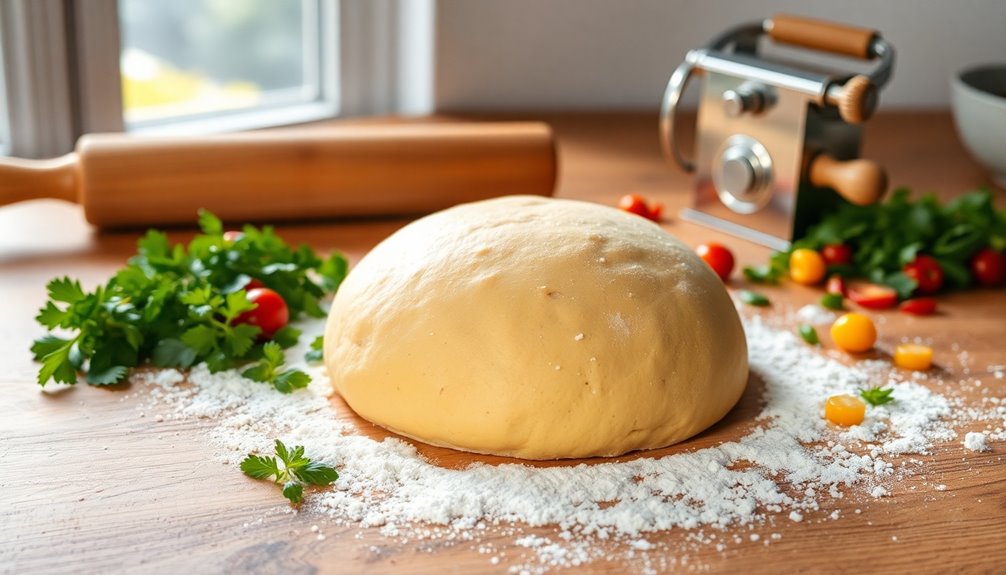
To create the ideal gluten-free pasta dough, you'll want to combine your selected flours in a bowl, mixing them thoroughly to ensure even distribution. Using a variety of gluten-free alternatives can enhance the flavor and texture of your pasta, so don't hesitate to experiment with different flour blends like almond, rice, or chickpea flour.
Focus on your mixing technique here, as it plays a pivotal role in achieving the right dough consistency. Once your flours are blended, add in your wet ingredients—a little water or an egg will help bind everything together. As you mix, pay attention to the texture; it should feel slightly tacky but not excessively sticky.
Here are a few tips to keep in mind while preparing your dough:
- Measure accurately: Precision in measuring your flours can greatly impact your dough.
- Rest your dough: Allow it to sit for about 30 minutes before rolling; this helps the flours absorb moisture.
- Knead gently: When incorporating your ingredients, knead the dough lightly to avoid overworking it.
- Adjust as needed: If your dough feels too dry, add a splash of water; if it's too wet, sprinkle in a bit more flour.
- Check the consistency: The final dough should be smooth and elastic, yet firm enough to hold its shape when rolled out.
Including a variety of flours can not only improve the texture of your pasta but also provide essential nutrients that promote overall health. With these tips, you're well on your way to mastering gluten-free pasta. Enjoy the process as you create something delightful that brings everyone together!
Rolling Out the Pasta
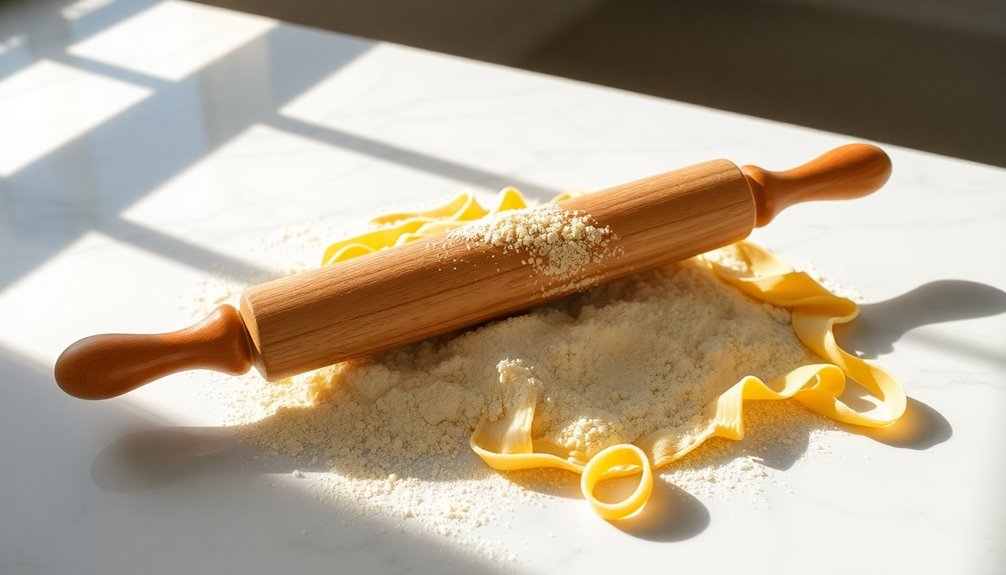
Once your gluten-free pasta dough has rested and reached the right consistency, it's time to roll it out into sheets. Start by dividing your dough into manageable portions; this makes it easier to handle and guarantees even thickness. Dust your work surface and rolling pin with a gluten-free flour blend to prevent sticking.
Now, let's delve into some rolling techniques. Begin with one piece of dough, flatten it slightly with your hands, and then roll from the center outward, applying even pressure. Rotate the dough a quarter turn after each roll to maintain a uniform shape. Aim for a thickness of about 1/16 inch—thinner if you prefer delicate pasta.
Incorporating techniques that promote muscle tone while cooking can also enhance your overall fitness routine.
If your dough starts to crack or resist rolling, don't panic! Here are some troubleshooting tips:
- If it feels too dry, lightly mist it with water and knead it gently.
- For overly sticky dough, sprinkle a bit more gluten-free flour on both the surface and the dough.
Cutting and Shaping Noodles
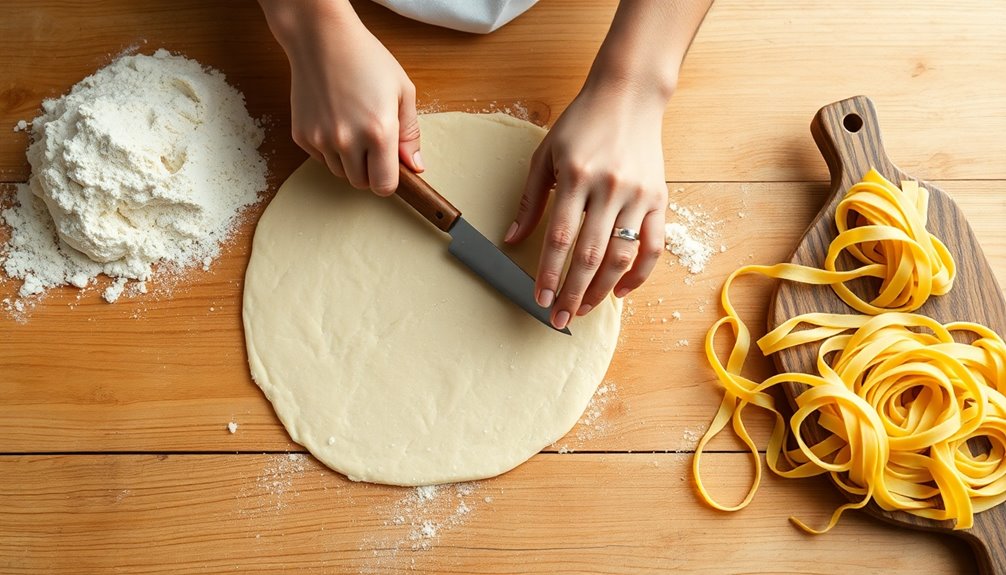
With the pasta sheets rolled out to your desired thickness, it's time to transform them into noodles. This is where the fun truly begins! You can create different shapes that can elevate any dish, making your gluten-free pasta feel special and inviting. Grab a sharp knife or a pasta cutter, and let your creativity flow.
Here are some popular shapes you might consider:
- Fettuccine: Perfect for rich sauces, cut your sheets into long, thin strips.
- Pappardelle: Go wider with your cuts for a hearty, rustic feel.
- Lasagna sheets: Keep them whole for layering in your favorite bakes.
- Ravioli: Cut squares and fill them with your favorite ingredients for a delightful surprise.
- Orecchiette: Roll small pieces into little discs for a unique texture.
As you cut, be mindful of the pasta thickness. This will affect cooking time and how the noodles hold onto sauces. Thicker noodles can be delightful, but they may require a longer cook. On the other hand, thin noodles cook quickly and can easily become mushy if you're not careful. Additionally, remember to engage in mindfulness meditation during the process to enhance your focus and creativity.
Once you've shaped your noodles, toss them with a bit of flour to prevent sticking. You're not just making pasta; you're crafting a dish that brings people together. Your kitchen will soon be filled with the aroma of your hard work, and your loved ones will appreciate the love and effort that went into each shape. Enjoy the process and take pride in every cut!
Cooking the Pasta
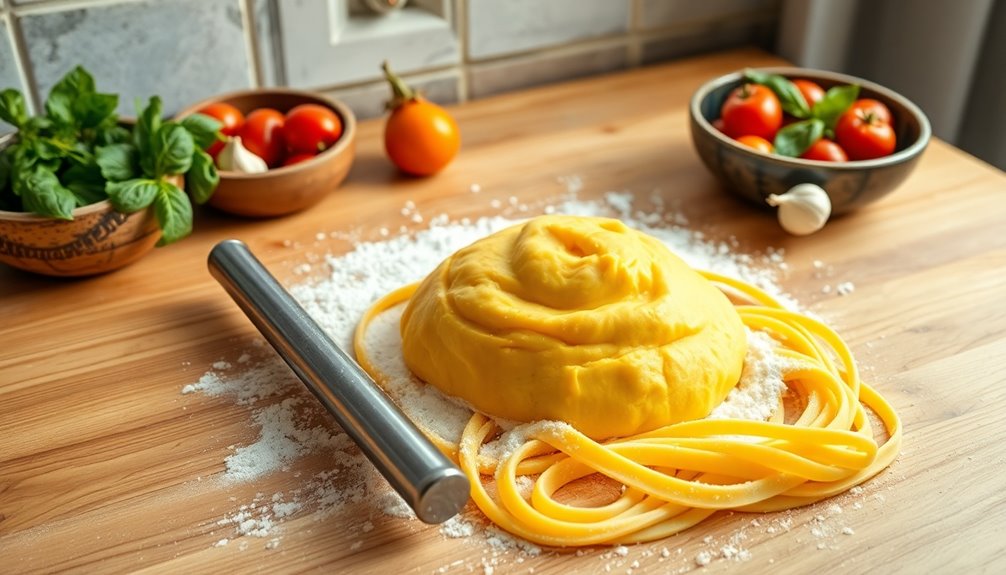
Cooking the pasta is where your hard work truly comes to life, transforming your freshly shaped noodles into a delicious meal. Start by bringing a large pot of salted water to a rolling boil. The salt not only enhances the flavor but also helps the pasta achieve the perfect texture.
Once the water's ready, gently add your noodles, being mindful not to overcrowd the pot. Depending on the thickness of your pasta, it usually takes about 3 to 5 minutes to cook. Remember, gluten-free pasta can be a bit more delicate, so keep an eye on it as it cooks.
As the pasta cooks, you can explore various cooking techniques. For a simple yet effective method, you can sauté the cooked pasta in a pan with a drizzle of olive oil and your favorite herbs for added flavor. This step not only adds depth but creates a delightful texture.
Once your noodles are ready, don't forget to reserve a cup of the pasta water—it's a secret ingredient that can help bind your sauce, making it creamy and cohesive.
When it comes to sauce pairings, the possibilities are endless. A light garlic and olive oil sauce works beautifully with thin noodles, while a robust marinara or rich alfredo complements thicker varieties. Experiment with different combinations, and don't shy away from adding fresh veggies or proteins to make the dish your own. Enjoy the process, and share your creations with friends and family for a true sense of belonging!
Flavoring Options
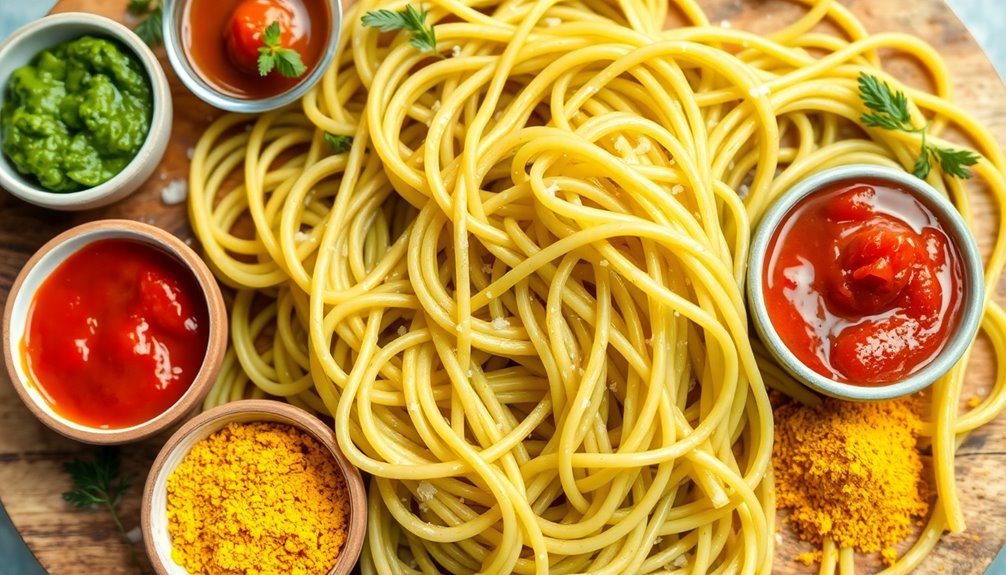
Flavor is the heartbeat of any pasta dish, and when it comes to gluten-free options, you've got a world of possibilities to explore. Crafting delicious gluten-free pasta isn't just about the noodles; it's about how you flavor them. By experimenting with seasoning techniques and sauce pairings, you can elevate your dish from bland to brilliant.
Here are some ideas to spark your creativity:
- Herb Infusions: Incorporate fresh or dried herbs like basil, oregano, or thyme right into your dough for a fragrant twist.
- Spice It Up: Add a pinch of chili flakes or smoked paprika to give your pasta a kick.
- Sauce Pairings: Consider creamy sauces like Alfredo or zesty options like marinara to complement the unique texture of your gluten-free pasta.
- Texture Preferences: Experiment with different gluten-free flours, such as chickpea or quinoa, to find the perfect bite that suits your taste.
- Garnish Ideas: Top your dish with a sprinkle of Parmesan, crushed nuts, or a drizzle of olive oil to add richness and visual appeal.
- Keto-Friendly Options: For those following a keto diet, incorporating healthy recipes can help you enjoy your gluten-free pasta while maintaining your dietary goals.
Storing Leftover Pasta
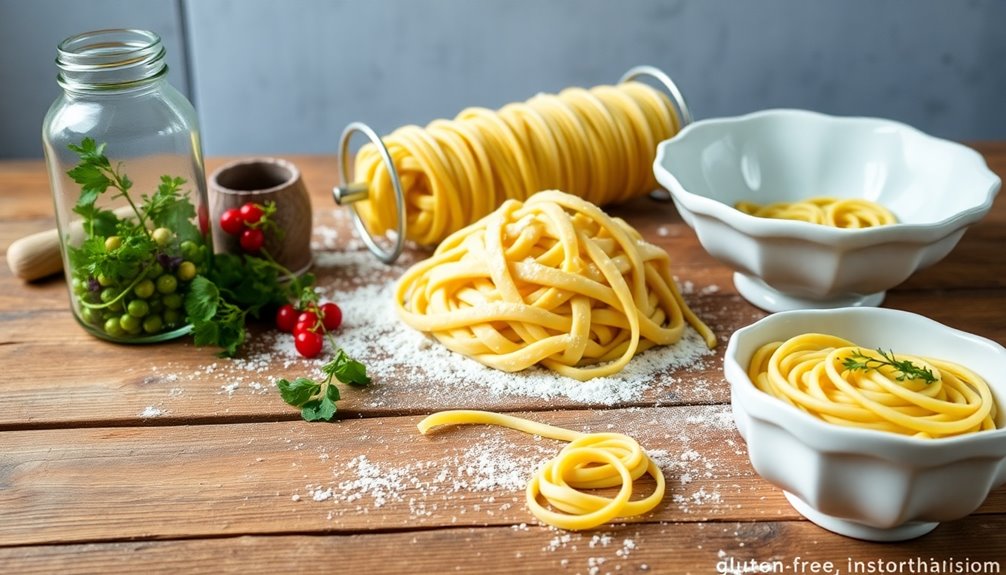
Leftover gluten-free pasta can be a delightful treat if stored properly. To make sure you enjoy it later without sacrificing flavor or texture, follow a few simple guidelines. Start by practicing portion control. Divide your pasta into meal-sized servings before storing, so you only reheat what you need. This not only prevents waste but also keeps your pasta fresh.
For long-term storage, consider freezing your pasta. First, let it cool completely. Then, toss it in a bit of olive oil to prevent sticking. Place the portions in airtight containers or freezer bags, removing as much air as possible. Label each bag with the date, and you'll have a stash of delicious pasta ready to go at a moment's notice. Remember, gluten-free pasta can lose its quality if stored too long, so try to use it within three months. Additionally, you can enhance your meal by incorporating anti-inflammatory foods, which can complement your pasta dishes.
When you're ready to enjoy your pasta, reheating methods can really make a difference. You can quickly reheat it in a pot of boiling water for a couple of minutes until warmed through.
Alternatively, toss it in a skillet with a splash of broth or sauce over medium heat, stirring until heated. This method helps revive the pasta's original texture and flavor.
Serving Suggestions
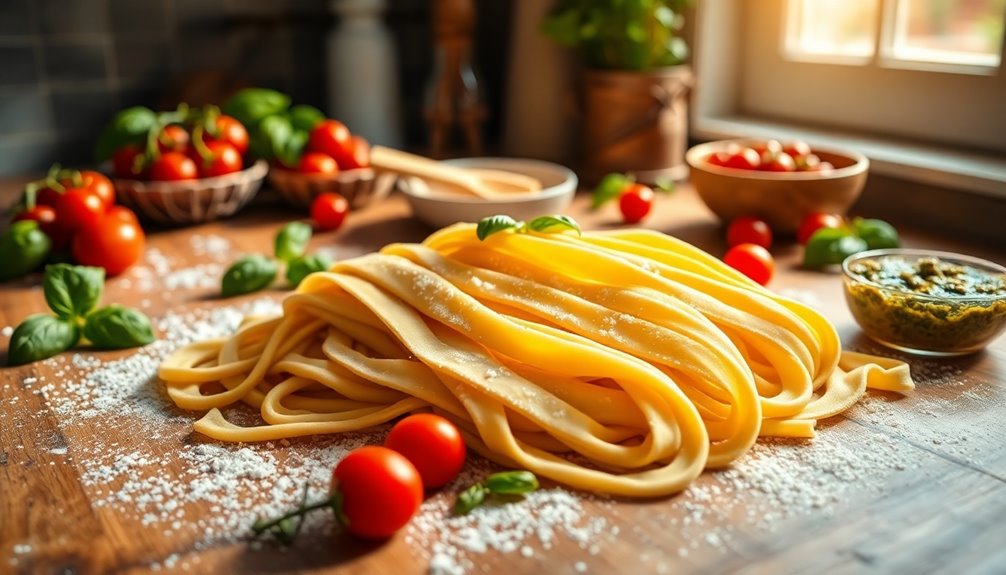
How can you elevate your gluten-free pasta experience? The right serving suggestions can turn your homemade creation into a delightful meal that everyone can enjoy. Start by considering the various pasta shapes you've made—each one carries its own unique charm and texture. Whether you've crafted delicate fettuccine or hearty penne, how you serve your pasta can make all the difference.
Here are some inspiring ideas to enhance your dish:
- Classic Marinara: Top your pasta with a rich, homemade marinara sauce, simmered with garlic, herbs, and a splash of olive oil.
- Creamy Alfredo: Pair a creamy Alfredo sauce with your fettuccine, and don't forget to sprinkle some fresh parsley for a pop of color.
- Pesto Perfection: Toss your pasta with vibrant basil pesto, adding roasted cherry tomatoes and pine nuts for an extra crunch.
- Fresh Veggies: Sauté seasonal vegetables like zucchini, bell peppers, or spinach, and mix them into your pasta for a fresh, healthy twist.
- Protein Boost: Incorporate grilled chicken, shrimp, or chickpeas to make your dish more filling and satisfying.
As you explore these toppings and sauces, remember that the joy of serving gluten-free pasta is about inclusivity. Losing weight can feel complicated and let everyone revel in the deliciousness together. Your gluten-free pasta isn't just a meal; it's an invitation to connect and enjoy!
Frequently Asked Questions
Can I Use a Pasta Machine for Gluten-Free Dough?
Yes, you can use a pasta machine for gluten-free dough, but you'll need to pay attention to moisture levels and dough consistency. Gluten-free dough tends to be more delicate, so hand rolling might be a safer alternative if you're unsure.
Experiment with different flours and keep the dough slightly moist to achieve the best results. Finding the right technique will help you feel more at home in your kitchen, creating delicious pasta everyone can enjoy!
How Long Can I Store Uncooked Gluten-Free Pasta?
Imagine a treasure chest filled with golden strands of uncooked gluten-free pasta, waiting to be transformed into a delicious meal.
You can store this treasure in a cool, dry place for about one to two weeks, ensuring it stays fresh. For longer shelf life, consider freezing it.
Experiment with recipe variations, and remember to check for cooking tips that can elevate your dish. This way, you'll always feel a sense of belonging in the kitchen!
Is Gluten-Free Pasta Suitable for Freezing?
Yes, gluten-free pasta's great for freezing! You've got a couple of freezing options: either freeze it uncooked for later use or cook it first before freezing. For best results, store it in an airtight container or freezer bag to prevent freezer burn. Remember to label it with the date.
When you're ready to enjoy it, just thaw it in the fridge overnight or cook it directly from frozen for a quick meal!
Can I Add Eggs to Gluten-Free Pasta Dough?
Sure, you can add eggs to gluten-free pasta dough! They'll enhance flavor and create a richer texture. If you're looking for egg replacements, consider using flaxseed meal or chia seeds mixed with water for a similar binding effect.
Experimenting with alternative flours like almond or chickpea can also add unique tastes and nutritional benefits. Embrace the process, and you'll discover a pasta that feels just right for you and your loved ones.
What Are Common Mistakes to Avoid When Making Gluten-Free Pasta?
When diving into gluten-free pasta, you want to avoid pitfalls like a chef dodging a rogue onion!
First, don't neglect flour substitutions; not all gluten-free flours behave the same. Experimenting is key.
Next, be mindful of your cooking techniques—overcooking can turn your masterpiece into mush.
Keep these tips in mind, and you'll create pasta that feels like a warm hug, inviting everyone to gather around the table.
Conclusion
Making gluten-free pasta from scratch is like discovering a hidden treasure in your kitchen—it's rewarding and delicious. With the right ingredients and a bit of practice, you can create pasta that rivals any traditional version. Whether you're enjoying a comforting bowl of noodles or impressing friends with your culinary skills, this homemade pasta will elevate your meals. So roll up your sleeves, embrace the process, and savor the joy of crafting your own gluten-free delight!



